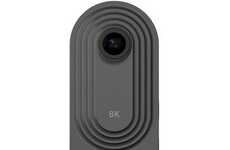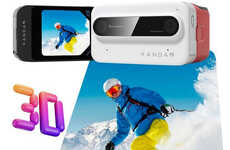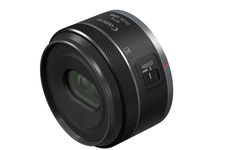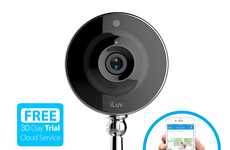
The LG 360 Cam Features Dual Fisheye Lenses
Michael Hemsworth — February 22, 2016 — Tech
References: lg & geeky-gadgets
The prevalence of virtual reality (VR) technology has brands creating solutions for consumers that enable their own content creation like the LG 360 Cam that features dual fisheye lenses.
Powered by an impressive 1,200 mAH battery pack and featuring connectivity including WiFi and Bluetooth, the LG 360 Cam weighs just 72-grams. The footage captured by the device is capable of being viewed on a Google Cardboard, which means the LG 360 Cam has the ability to expand VR capabilities for all kinds of users.
After footage has been recorded, the LG 360 Cam is intended to make uploading the content to social media sites like YouTube easy. Although the pricing and worldwide availability of the LG 360 Cam is currently unknown, it's likely the device will impress photography buffs everywhere.
Powered by an impressive 1,200 mAH battery pack and featuring connectivity including WiFi and Bluetooth, the LG 360 Cam weighs just 72-grams. The footage captured by the device is capable of being viewed on a Google Cardboard, which means the LG 360 Cam has the ability to expand VR capabilities for all kinds of users.
After footage has been recorded, the LG 360 Cam is intended to make uploading the content to social media sites like YouTube easy. Although the pricing and worldwide availability of the LG 360 Cam is currently unknown, it's likely the device will impress photography buffs everywhere.
Trend Themes
1. Virtual Reality Content Creation - The prevalence of VR technology is driving brands to create solutions that enable consumers to easily create VR content.
2. Dual Fisheye Lens Technology - The use of dual fisheye lenses in VR cameras like the LG 360 Cam allows for more immersive and realistic VR experiences.
3. Seamless Social Media Integration - VR camera devices like the LG 360 Cam are focused on making it easy for users to upload and share their VR content on social media platforms.
Industry Implications
1. Consumer Electronics - Consumer electronics companies can capitalize on the growing demand for VR cameras, creating innovative devices to enhance the content creation experience.
2. Photography - The photography industry can leverage dual fisheye lens technology to offer new and unique VR photography services to consumers.
3. Social Media - Social media platforms have the opportunity to integrate VR features into their platforms, allowing users to easily share and view VR content.
4.3
Score
Popularity
Activity
Freshness























